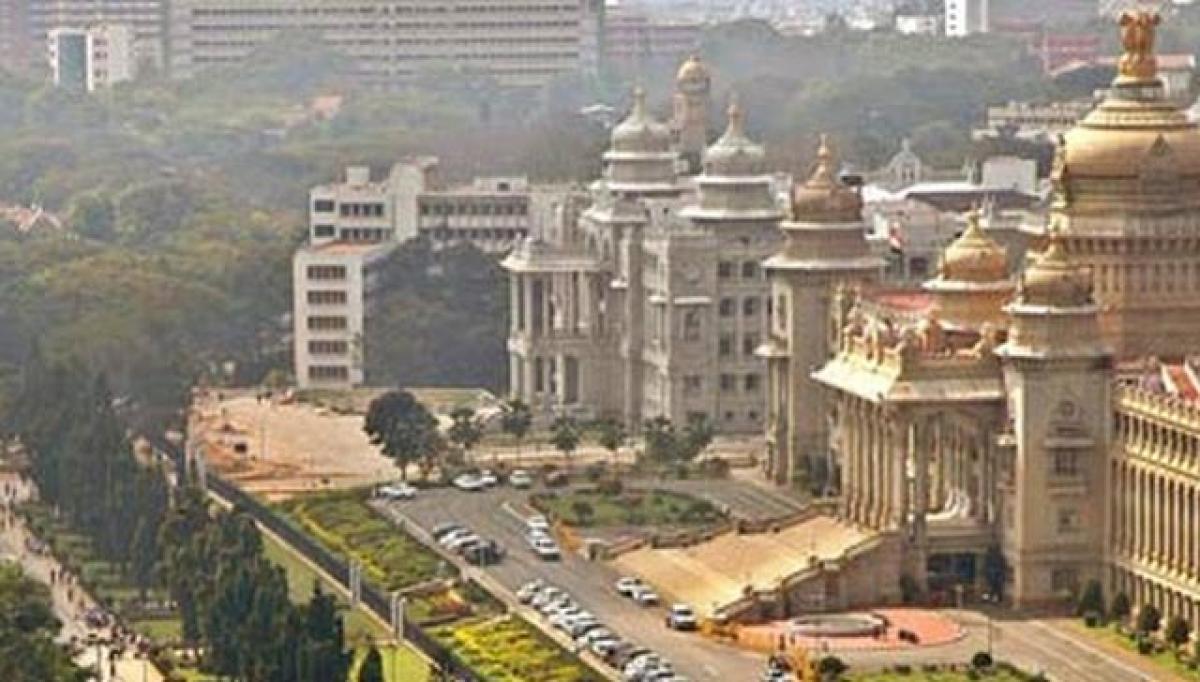Live
- Varun's appointment as AHUDA chief infused new vigour in JSP cadres
- Lokayukta, HRC will remain in Kurnool: Minister Bharath
- S Korea, US, Japan unveil secretariat establishment, slam N Korea-Russia on Ukraine war expansion
- Light to Moderate Rains Expected in Telangana and Andhra Pradesh
- Pilgrims throng Sabarimala temple on opening day of long festive season
- Jwala Thoranam held at Srisailam temple
- Birsa Munda Jayanti celebrated
- Another tigress released in soft enclosure in Similipal
- Coastal defence exercise on Nov 20-21
- Budget allocated for Perur reservoir rekindles farmers’ hope
Just In
Will sizzling Bengaluru regain its epithet of weather paradise?


Bengaluru can regain it past climate if we restore the lakes and avoid concrete highrise buildings
Bengaluru: It was an airy, cool city. People flocked to it for its weather. Many shifted their place of residence to enjoy the daily evening cool breeze and drizzle. Even in peak summer, no fan was required.
Now, Bengaluru is sizzling. Residents have been buying air conditioners for many summers. These are being operated from early March.
What is happening to the weather paradise?
"In the 1950s and 60s, none of the houses in Bengaluru had fans. In June I used to wear a sweater. Now you cannot imagine that," the chairperson of Divecha Centre for Climate Change (DCCC), Indian Institute of Science (IISc), J. Srinivasan, told IANS.
On Sunday, April 24, 2016, Bengaluru recorded its highest temperature since 1931 at 39.2 degrees Celsius, eclipsing the previous record of 38.3 degrees Celsius, recorded 85 years ago.
Srinivasan said the average minimum and maximum temperatures in Bengaluru rose by five and three degrees Celsius, respectively, in April 2016.
According to experts, explosive urbanisation, El Nino effect, rising tar roads, concrete buildings and global warming are some of the major attributes causing the Urban Heat Island (UHI) effect in Bengaluru.
"Last year was an El Nino year, in which the sea surface temperatures of Southern Pacific Ocean had risen by three to four degrees. This kind of a weather pattern affects the Indian Subcontinent which leads to warming," Geeta Agnihotri, head of Meteorological Centre, India Meteorological Department, Bengaluru, told IANS
The Meteorological Centre, tasked to measure weather, has only three observatories for the huge city with a population of nearly 10 million and an area north of 741 square kilometres. "We have observatories in the city (Palace Road), HAL airport and Kempe Gowda International Airport," Agnihotri said.
That, according to some experts, excludes vast swathes of the city encompassing areas like the Electronic City, Whitefield and others which may have shown higher temperatures this summer, but find no mention in official records.
The many concrete housing societies and office buildings in the city contribute to the UHI effect, resulting in widely varying micro and macro climate. Concrete absorbs heat and retains it for a long time, say experts.
"Both bricks and concrete are things that absorb solar radiation and in the night re-radiate it into the room. That's why all of us feel the concrete furnace in the house. If you go out, it is cooler outside (Macro-climate), though," said Srinivasan.
"Having massive walls in a cold country is good to store heat and keep the warmth. India requires the opposite. Also, we have too much glass in our buildings. Glass is not good for India. Glass allows radiation to come inside the room and heats it up but it cannot go out," said Srinivasan, a radiation expert.
Senior researcher at DCCC Rajiv Chaturvedi said global temperature has already increased by one degree Celsius and the thought of it further spiking is worrying. "Unless global temperatures are capped at safe levels, Bengaluru climate will further deteriorate," said Chaturvedi.
He said strong action on a global level was needed to mitigate climate change and it is important that global mean temperature is not allowed to go above two degrees Celsius," Chaturvedi told IANS.
His solution: Promote mass rapid transport system, follow green and sustainable lifestyle, conserve water and electricity, and plant more trees. "There is a need to increase the ratio of green spaces vis-a-vis concrete spaces," he said.
Bengaluru is doing its bit to expand the public transport system. "It is a continuous process. As the city expands, Metro will have to catch up. Phase I and Phase II should be over by 2020. 2020 will be an important year," Managing Director of Bangalore Metro Rail Corporation Limited, Pradeep Singh Kharola, told IANS.
He said the city would have a metro network vastly bigger than the present length of 33 kilometres, largely on the lines of Delhi which has over 200 kilometres of the transport system. But that's still years away.
What can be done to bring back some of the temperature patterns which old-timers are so fond of recalling? "Bengaluru can regain it past climate if we restore the lakes and avoid concrete highrise buildings," said Srinivasan.
The city had hundreds of lakes which were encroached upon by the expanding demand for housing and offices, leading to their disappearance. The solution may be a tall order, but it may be worth it if the city is to regain its epithet of weather paradise

© 2024 Hyderabad Media House Limited/The Hans India. All rights reserved. Powered by hocalwire.com






